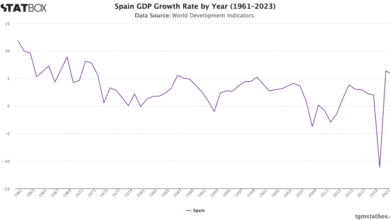Producer Price Index: June Shows Unexpected Stability
The Producer Price Index (PPI) serves as a crucial indicator of wholesale inflation, reflecting how changes in raw materials and production costs affect pricing across various sectors. In June, the PPI surprisingly showed no change, defying expectations for a 0.2% rise, which has stirred discussions among economists regarding the ongoing impact of tariffs on the economy. Despite this stagnation, prices for final demand goods saw a slight increase of 0.3%, hinting at potential inflationary pressures elsewhere, while a decline in services added complexity to the PPI report. This nuanced data, combined with consumer price index figures, suggests that the impact of President Trump’s tariffs may be limited. As the Federal Reserve monitors these indicators closely, the interplay between PPI trends and interest rates remains a focal point for policy discussions moving forward.
When assessing inflation trends within the economy, the wholesale price gauge known as the producer price index (PPI) plays a significant role. This metric captures the cost changes that producers face before products reach consumers, making it a vital tool for understanding inflation dynamics. Recent reports reveal stagnant pricing in June, contrasting earlier predictions of a 0.2% increase, which raises questions about broader economic factors, including tariff implications. In consideration of other inflation measurements, such as the consumer price index (CPI), market analysts remain vigilant about how these data points influence the Federal Reserve’s decisions on interest rates. The complexity of these relationships underlines the ongoing debate about the ramifications of tariffs on economic stability and inflationary expectations.
Understanding the Producer Price Index (PPI)
The Producer Price Index (PPI) serves as a crucial economic indicator reflecting the average changes in selling prices received by domestic producers for their output over time. In June, the PPI showed no change, contrary to economists’ expectations for a 0.2% rise. This stability in wholesale prices indicates that inflationary pressures at the producer level are currently subdued, which may influence wider economic conditions. Understanding this index can shed light on how price changes at the wholesale level can eventually trickle down to consumers.
Moreover, the core PPI, which excludes food and energy prices, also held steady, suggesting that inflation is not being driven by volatile components. This flat performance indicates that any potential inflationary pressures might be more nuanced and not directly linked to the current tariff policies. As such, the data generated by the PPI is vital for economists and policymakers, particularly in gauging the future trajectory of the economy and making informed decisions regarding interest rates.
Frequently Asked Questions
What is the producer price index (PPI) and how does it relate to wholesale inflation?
The producer price index (PPI) measures the average change over time in the selling prices received by domestic producers for their output. It’s a key indicator of wholesale inflation, reflecting the pricing power of manufacturers and suppliers in the economy.
How did the latest PPI report affect perceptions of tariffs’ impact on the economy?
The latest PPI report showed no change in June, conflicting with expectations of a 0.2% increase. This suggests that current tariffs are having only a marginal effect on the U.S. economy, as both wholesale and consumer price indices indicate stable pricing.
What does a flat PPI indicate about future inflation trends?
A flat PPI indicates that wholesale costs are not rising, which could suggest stable inflation trends. However, fluctuating prices within specific categories, such as a 0.3% rise in final demand goods, highlight that certain sectors may still experience price pressures.
How does the producer price index impact Federal Reserve interest rates?
The producer price index can influence Federal Reserve interest rates by providing insights into inflation trends. If PPI data suggests rising wholesale prices, the Fed might consider adjusting interest rates to manage inflation, although current forecasts indicate stability.
What are the recent trends in the consumer price index (CPI) compared to the producer price index?
Recent trends show the consumer price index (CPI) rose by 0.3%, with an annual inflation rate of 2.7%, while the PPI remained unchanged. This divergence highlights that consumer-level inflation may differ from wholesale price trends.
Why is the core PPI an important measure in analyzing economic health?
The core PPI, which excludes volatile items like food and energy, is essential for analyzing economic health because it provides a clearer picture of underlying inflation trends without the noise of price fluctuations in essential commodities.
What role do tariffs play in influencing PPI and wholesale inflation?
Tariffs can impact the producer price index and wholesale inflation by increasing costs for imported goods, potentially leading to higher prices for consumers. However, the latest data suggest that their effect on the broader economy and pricing may be limited.
How do changes in the PPI report affect consumer prices?
Changes in the PPI report can lead to adjustments in consumer prices, as higher wholesale prices often translate into increased costs for retailers, which may then be passed on to consumers in the form of higher prices in the consumer price index.
What does a year-over-year increase of 2.3% in the headline PPI indicate?
A year-over-year increase of 2.3% in the headline PPI indicates ongoing inflationary pressures at the wholesale level, although this is a decrease from the previous month, suggesting a potential easing in inflation dynamics.
How can investors interpret changes in the PPI and consumer price index data?
Investors can interpret changes in the PPI and consumer price index data as signals of economic health. Stable or declining inflation might indicate steadiness in markets, while rising inflation could prompt concerns over potential rate hikes by the Federal Reserve.
| Key Point | Details |
|---|---|
| Producer Price Index (PPI) Overview | The PPI showed no change in June, defying expectations of a 0.2% increase. |
| Core PPI Results | The core PPI was also flat, indicating subdued wholesale inflation. |
| Final Demand Goods vs. Services | Prices for final demand goods rose by 0.3%, while services declined by 0.1%. |
| Impact of Tariffs | The data suggests President Trump’s tariffs are having only a marginal impact on inflation in the U.S. |
| Year-over-Year Changes | The headline PPI increased by 2.3% annually, down from 2.7% in May, marking the lowest since September 2024. |
| Current Economic Sentiment | Stock futures rose while Treasury yields decreased post-report. Economists anticipate no near-term Fed rate cuts. |
Summary
The producer price index is a crucial economic indicator that reflects wholesale price changes. In June, it showed no movement, contrary to forecasts of a 0.2% rise, hinting at a stable inflation environment amid tariff impacts. While prices for final demand goods showed a slight increase, overall figures suggest limited changes in the broader economic landscape, with no immediate action expected from the Federal Reserve regarding interest rates. This nuanced scenario indicates the ongoing complexities in inflation dynamics influenced by domestic economic policies.



